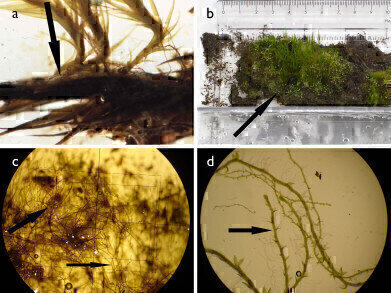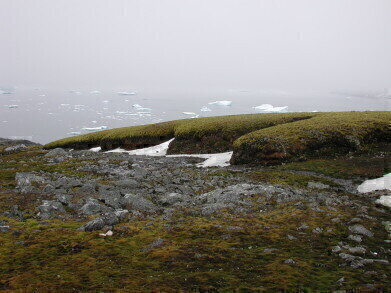-
 Moss re-growth at different depths in the core.(A) Site of new growth emerging from existing gametophytes on the fresh-cut face of the core at 110 cm depth (arrow). (B) Extensive regrowth of Chorisodontium aciplyllum from the
Moss re-growth at different depths in the core.(A) Site of new growth emerging from existing gametophytes on the fresh-cut face of the core at 110 cm depth (arrow). (B) Extensive regrowth of Chorisodontium aciplyllum from the -
 West coast deep moss bank (credit: Peter Boelen)
West coast deep moss bank (credit: Peter Boelen)
News
From old to new - 1,500 years in permafrost and growing
Mar 28 2014
Specimens of moss that have been frozen for more than 1500 years in the Antarctic have successfully been revived by researchers from the British Antarctic Survey (BAS) and the University of Reading. Cores taken from frozen ice banks were carefully prepared and cultivated in an incubator under normal growth temperature and light levels. After only a few weeks, the moss began to grow. Using carbon dating, the team identified the moss to be at least 1,530 years of age, and possibly even older, at the depth where the new growth was seen.
As the dominant plants in both polar regions, mosses are major storers of fixed carbon and play an important role in glacial environments. This study* is the first to indicate such long-term survival in any plant; similar timescales have only been seen before in bacteria.
Professor Peter Convey from the British Antarctic Survey explains:
“What mosses do in the ecosystem is far more important than we would generally realise when we look at a moss on a wall here for instance. Understanding what controls their growth and distribution, particularly in a fast-changing part of the world such as the Antarctic Peninsula region, is therefore of much wider significance.”
“This experiment shows that multi-cellular organisms, plants in this case, can survive over far longer timescales than previously thought. These mosses, a key part of the ecosystem, could survive century to millennial periods of ice advance, such as the Little Ice Age in Europe.
“If they can survive in this way, then recolonisation following an ice age, once the ice retreats, would be a lot easier than migrating trans-oceanic distances from warmer regions. It also maintains diversity in an area that would otherwise be wiped clean of life by the ice advance.
“Although it would be a big jump from the current finding, this does raise the possibility of complex life forms surviving even longer periods once encased in permafrost or ice.”
Reference
*Millennial timescale regeneration in a moss from Antarctica by Esme Roads, Royce E. Longton and Peter Convey; Current Biology, 17 March 2014.
Digital Edition
Lab Asia Dec 2025
December 2025
Chromatography Articles- Cutting-edge sample preparation tools help laboratories to stay ahead of the curveMass Spectrometry & Spectroscopy Articles- Unlocking the complexity of metabolomics: Pushi...
View all digital editions
Events
Jan 21 2026 Tokyo, Japan
Jan 28 2026 Tokyo, Japan
Jan 29 2026 New Delhi, India
Feb 07 2026 Boston, MA, USA
Asia Pharma Expo/Asia Lab Expo
Feb 12 2026 Dhaka, Bangladesh


















